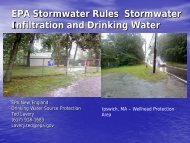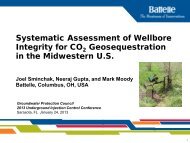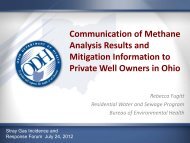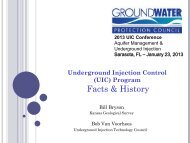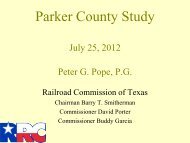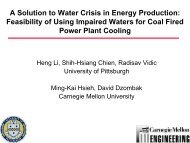Kirk Martin
Kirk Martin
Kirk Martin
You also want an ePaper? Increase the reach of your titles
YUMPU automatically turns print PDFs into web optimized ePapers that Google loves.
Apparent Upward Migration:<br />
Diagnostic Strategies That Can Save<br />
Stewart J. Magenheimer, P.G.<br />
W. <strong>Kirk</strong> <strong>Martin</strong>, P.G.,<br />
CPG, CGWP<br />
Your Deep Injection Well January 2013
Agenda<br />
• UIC design in Florida<br />
• Regulatory background<br />
• Compliance strategies<br />
• Diagnostic tools<br />
• Case studies
UIC Design in Florida
Upward Migration Typical Understanding
Regulatory Background - Florida<br />
• No fluid movement UIC standard<br />
• On December 22, 2005, the EPA adopts final rule applicable to<br />
Class I UIC facilities in 24 counties in Florida<br />
• Florida adopts rule into 62-528, F.A.C.<br />
• Provides for regulatory alternatives for Class I municipal UIC<br />
facilities with apparent fluid migration issues<br />
• New Class I municipal UIC facilities must meet new treatment<br />
requirements (filtration, HLD)
Regulatory Strategies Available for Resolving<br />
UIC Permit Compliance Issues<br />
• Demonstrate no unacceptable fluid migration has occurred (WQ)<br />
• Show acceptable natural attenuation/aquifer exemptions<br />
• Develop contamination assessment/implement remediation plan<br />
• Implement treatment<br />
process improvements
Brevard County Location Map<br />
Melbourne Grant<br />
Street WRF<br />
Brevard South<br />
Beaches WRF
Aerial Photos of County South Beaches WRF and<br />
Melbourne Grant Street WRF<br />
Brevard South Beaches WRF<br />
Melbourne Grant Street WRF<br />
8.0 mgd<br />
5.5 mgd
Acknowledgements<br />
• Brevard County Utility Services Department<br />
– Bob Adolphe, P.E., Director<br />
– Craig Helpling, Project Manager<br />
– Dick Martens, P.E., Former Director<br />
• City of Melbourne Engineering Department<br />
– Jenni Lamb, P.E., City Engineer<br />
• City of Melbourne Public Works & Utilities Department<br />
– Ralph Reigelsperger, P.E., Director<br />
– Harold Nantz, P.E., Asstistant Director<br />
• FDEP UIC Section
Brevard South Beaches WRF DIW System
South Beaches DIW Was Experiencing Apparent<br />
Upward Migration Issues
Regulatory History<br />
• CO issued 1993<br />
• AO issued 1996<br />
• SPR submitted 2007<br />
• RFI received 2009<br />
• FDEP – Fluid<br />
migration evident<br />
• Ongoing operations<br />
maintained<br />
• Diagnostic plan<br />
developed
Mosaic Approach: Would the Same Well<br />
Design Decisions Be Made?<br />
System Design<br />
Lithology<br />
Groundwater<br />
Chemistry<br />
Regional<br />
Hydrogeology<br />
Geophysical Logs
Key Diagnostic Tools Considered<br />
• Define compositional differences<br />
between injectate and ambient groundwater<br />
• Understand wastewater treatment processes<br />
and sources to identify chemical approaches<br />
• Apply non-routine tools<br />
– Spectroscopic screening<br />
– Microconstituent fingerprinting<br />
– Groundwater age dating
Spectroscopic Screening Provided Economical<br />
Means to Evaluate Water Compatibility Issues<br />
• Exploit differences in organic material content between<br />
wastewater and groundwater<br />
– 3D UV fluorescence spectroscopy (EEM)<br />
– Large-scale inexpensive screening technique<br />
– Determines if more intensive study is needed<br />
Impacted Sample Potential Source #1<br />
Potential Source #2
Microconstituent Fingerprinting<br />
• Using anthropogenic tracers<br />
• Widely metabolized compounds<br />
– Caffeine<br />
– Acetaminophen
Groundwater Age Dating Supported No Upward<br />
Migration of Injected Fluids<br />
• Application of tritium analyses indicated significant differential<br />
between injection well and MW3
Well Construction/Hydrostratigraphic Evaluations<br />
Indicated Monitor Well Penetrated Confining Beds
Apparent Upward Migration Issue Was Successfully<br />
Addressed for the Brevard South Beaches DIW<br />
• Well design would be<br />
different today<br />
• Rescinded an<br />
administrative order<br />
• Avoided new consent order<br />
• Redefined injection and<br />
confinement zones<br />
• Avoided costly wastewater<br />
process changes<br />
• Saved Brevard County $10M
City of Melbourne Grant Street WRF DIW System
City of Melbourne Grant Street WRF<br />
DIW System<br />
Melbourne Grant Street WRF
Regulatory History – Grant Street<br />
• Consent and Administrative Orders 1988 to present<br />
• Anomalous water quality in MW samples<br />
• Issues with MW mechanical integrity and flow<br />
• Water quality studies conducted – inconclusive<br />
– Effluent/groundwater<br />
– Age dating
Log and Lithologic Evaluation Supported<br />
Demonstration of Confinement
Water Quality Data Trends Indicated Anomalies<br />
• Merge of data sets<br />
• Sharp change in 1996
Pressure Trends Confirmed Anomalies<br />
• Merging trends
Well Construction/Hydrostratigraphic Evaluations<br />
Indicated Monitor Wells in Communication
Mechanical Integrity Issue Indicated<br />
• Installation of new monitor wells
Conclusions Developed From Upward Migration<br />
Evaluations in Brevard County<br />
• Detailed microconstituent and spectroscopy shows promise<br />
• Tritium analyses – mixed results<br />
• Understanding of site hydrostratigraphy is improved with<br />
operational data and new diagnostic tools applied<br />
• Evaluate the system design in total<br />
• Multi-level diagnostic strategies needed – just one won’t do<br />
• Don’t give up – look hard
Apparent Upward Migration:<br />
Stewart Magenheimer PG<br />
Diagnostic Strategies That Can<br />
<strong>Kirk</strong> <strong>Martin</strong> PG<br />
Save Your Deep Injection Well January 2013




